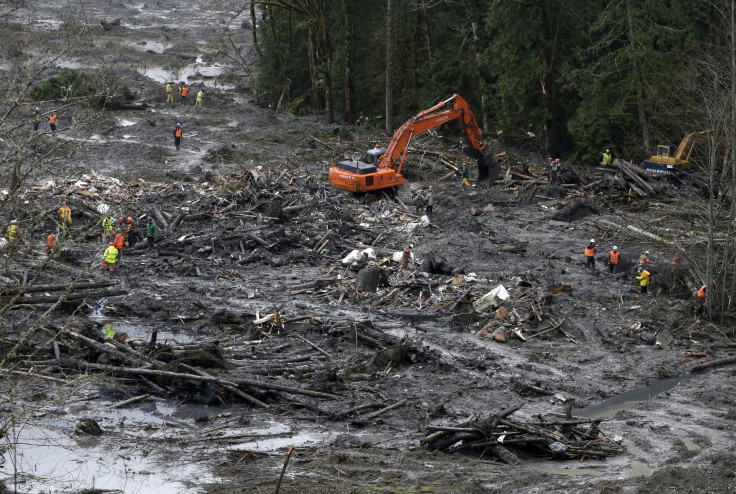Washington Mudslide Linked To Logging As Scientists Hunt For 'Trigger' Of Deadly Slide

The massive mudslide that struck March 22 near the small town of Oso, Wash., wiped out more than two dozen homes and claimed the lives of at least 29 people. Several others are still unaccounted for or missing. As rescue workers continue to comb the muck and rubble for survivors, scientists are beginning to search for clues to what caused the deadly Stillaguamish River Valley mudslide.
Investigators will pay close attention to the effect logging could have had on the mountainside after The Seattle Times reported that the data used by state regulators to create logging boundaries was outdated. According to the paper, officials failed to incorporate newer research into their analysis that would have restricted logging on the slope that collapsed on the outskirts of Oso.
When the Washington Department of Natural Resources, which manages more than 3 million acres of commercial lands, approved the clear-cutting of more than seven acres on the plateau in 2004, it used logging boundaries drawn in 1988. But a 1997 report by the Department of Ecology, the environmental regulatory branch of the state government, drew new boundaries based on an analysis of where groundwater could increase the risks of landslides.
Had the new data been considered, it would have spared an additional 12 acres to the west of the plateau from being logged.
According to geologists, the Stillaguamish River Valley is ripe for landslides. The landscape, National Geographic notes, is dominated by loose sand and gravel that melting glaciers deposited during the last ice age. The gravel sits atop a layer of clay that is firmly resistant to absorbing water. When it rains, water can pool on top of this clay layer and loosen the gravel above it. When the layer of dirt becomes too weak, it can collapse.
Trees help stem this process. Plants intercept and absorb water; removing them can increase the soil’s saturation and contribute to the likelihood or severity of a landslide.
"The Oso landslide is one of many landslides that have occurred on slopes in the valley," Geotechnical Extreme Events Reconnaissance Association said in a statement. "The Oso landslide became a rapidly moving, channelized debris flow that spread out as it travelled about 0.5 miles, damming the North Fork of the Stillaguamish River.”
A team of six scientists from GEER will be dispatched next week to search for clues as to what caused the Washington mudslide. Researchers will interview witnesses, collect data and conduct measurements in the field.
"The question is, 'What was the trigger? What was the threshold that was exceeded?'" Joseph Wartman, a civil engineer at the University of Washington in Seattle, told National Geographic. "Whether we will be able to know that, I'm not sure."
Investigators will certainly consider the role logging and weather could have played in the deadly slide. According to Oregon Live, weather stations reported 13.8 inches of rain in the 30 days leading up to the slide, which may have loosened the gravel and caused the collapse.
"I can't even put my finger on a really clear, defensible, definitive study that says 'Yes, logging matters for deep-seated landslides,'" Josh Roering, a geomorphologist at the University of Oregon, Eugene, told National Geographic.
© Copyright IBTimes 2025. All rights reserved.






















